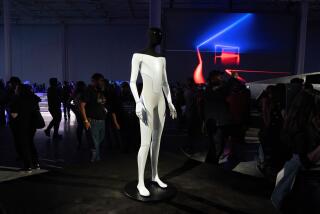Army’s Right Man for the Job Is a Robot
- Share via
DUGWAY PROVING GROUND, Utah — “Manny” looks a bit the worse for wear, suspended in an Army warehouse with his stainless steel joints and plastic sensors exposed and a dusty black rubber mask on his head.
But U.S. soldiers will someday have the mechanical man to thank for the effectiveness of their protective clothing.
“What we are hoping to achieve is to give the soldier greater confidence in the protective materiel he has available to him,” said Lothar Salomon, scientific director at this remote post in Utah’s western desert.
Salomon said he realized in 1985 that static mannequins and simulated chemicals were not realistic enough to gauge clothing’s protective capacity.
“It just occurred to me, through various tests and results, that we should be able to do a better job in the testing of protective gear,” he said.
The idea was born for Manny, a $2.8-million robot Salomon calls “the closest thing to a human being possible.”
The Army sent its specifications to Battelle’s Pacific Northwest Laboratories in Richland, Wash., which had devised robotics for the Department of Energy to handle radioactive materials.
Last November, Battelle delivered the 5-foot-11, 187-pound robot, which is attached by a mechanical arm at the small of the back to a stainless steel control unit housing hydraulics and electrical systems.
Later this year, Battelle will ship a hermetically sealed test chamber capable of containing such agents as chemical vapors and nerve gas, said David W. Bennett, technical group leader for mechanical systems and robotics.
Manny will operate within the chamber in an undisclosed building on the 840,000-acre base, where the Army tests defenses against chemical warfare in the event it becomes a reality despite treaties banning it, Salomon said.
The base obtained permission for such tests in 1982, said spokeswoman Kathy Whitaker.
Tests involving biological agents aren’t planned for the near future, but they are “within the realm of possibility,” Salomon said.
A clear plastic molded on forms sculpted in aluminum gives Manny human shape, and electrical heaters keep a “skin” temperature at an even 98.6 degrees.
Even without the outer skin of butyl rubber, Manny cuts an eerily human figure. His 38 joints are powered by rotary and linear actuators that enable him to walk at 3 m.p.h., crouch, wave, sit, stand and crawl as guided by a computer.
The skin is fitted with sensors that can detect penetration of one-billionth of an ounce of a chemical or nerve agent. Perspiration is achieved by water coursing through capillary tubes on the surface of the rubber, and moist air is injected at the nose and mouth as air bladders in the chest expand and contract.
Such realism is necessary to ensure that the stresses of human movement, particularly on seams, won’t compromise protective material that might be subtly altered by a soldier’s breath, said program manager Chuck DeWitt.
While toxic substance protection is Manny’s prime mission, the robot also is likely to be used to test the spectrum of military garb from firefighting gear and flight suits to field uniforms.
DeWitt and computer operator Jim Barnes have spent well over 500 hours testing Manny’s systems and writing movement programs.
More to Read
Sign up for Essential California
The most important California stories and recommendations in your inbox every morning.
You may occasionally receive promotional content from the Los Angeles Times.










